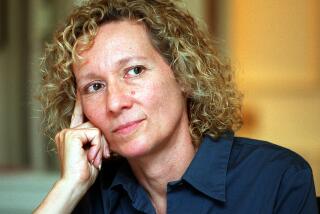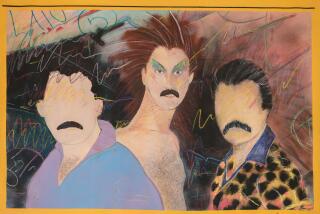Why you need to know the photography of Ricardo Valverde
Art history is a funny thing. It will focus on some stories (relentlessly), while often completely ignoring others. The ‘70s in L.A. art will often conjure images of Chris Burden having himself shot in the arm or Lewis Baltz photographing the blocky industrial parks rising on the outskirts of Irvine. But it doesn’t necessarily bring to mind artists like Ricardo Valverde, who were pushing photography to its limits. That is a shame, because Valverde’s pictures provide a singular viewing experience: an intimate portrait of his personal life, an innovative use of the lens (odd angles, dramatic framing, trippy reflections), and a vital window into L.A.’s Chicano culture in the 1970s.
Thankfully, that is being remedied with an engaging retrospective of the artist’s work being held at the Vincent Price Art Museum (VPAM) at East Los Angeles College. Organized by independent curator and UCLA visiting scholar Cecilia Fajardo-Hill, the exhibition gathers more than 100 pieces from throughout the artist’s career. This includes early experimental ceramics, videos, photographs from the MFA thesis he completed at UCLA, as well as later works in which he began cutting, collaging, ripping, tearing and painting over his own photographic works -- blurring the boundary between photography and other art-making practices.
Fajardo-Hill says she first stumbled upon the artist’s work when she worked on the “MEX/L.A.” show at the Museum of Latin American Art in Long Beach. “Rubén Ortiz-Torres, the curator of that show, brought him to my attention ... and I was like, ‘Wow, this is unbelievable!’” she says. “This was an artist whose work encompassed so many aspects. In the photos of [his wife] Esperanza, you see a very open approach to the body. You see a relationship that has to do with passion. You see interesting ideas about the photographic eye. The more you look, the more layers you see.”
Valverde was a longtime L.A. photographer who never quite received his due in his lifetime. (He passed away of a brain tumor in 1998 at the age of 51.) Born and raised in Phoenix, he came to Los Angeles in his early teens, where he attended Cathedral High School and first developed an interest in photography.
After high school, he joined the Air Force. “This was during the Vietnam War,” recalls his widow, Esperanza Valverde, “and he did not want to be drafted.” In the service, he worked as a journalist on an Air Force newspaper. After he was discharged, he ended up at UCLA, where he received both his bachelor’s and master’s degrees in fine art.
For much of his life, Valverde worked at the Department of Water & Power as a meter reader. “He was never capable of having a regular desk job, a 9 to 5,” says Esperanza. “When they hired him, he was very excited at the opportunity of being out in different neighborhoods. His supervisors didn’t know it, but he always had his camera and he used it as an opportunity to shoot.”
And photography was always his constant. Though he dabbled in other art forms, including ceramics and video, the camera was a regular companion with which he captured tender moments with his wife and son, abstract bits of landscape, fragments of signage and young men in his East L.A. neighborhood around Estrada Street, and later in Highland Park. He also had an affinity for low rider culture, which makes appearances throughout his work.
Despite his keen eye and technical facility, the content of his photographs weren’t embraced by mainstream art circles in the Los Angeles of the 1970s. One advisor at UCLA encouraged him to go a more commercial route. “They discouraged him,” recalls Esperanza. “They could not relate to his experiences and sensibilities. One teacher asked him the value of shooting the people in his neighborhood. But he was not discouraged. Ricardo saw importance in the everyday people in his life. He felt that a photo of them was as important as any photo you might find in the Norton Simon.”
As his career progressed, his work was also too often lumped with the work of documentary photographers. That, however, misses a large part of what he was about, says Fajardo-Hill. “He was a powerful conceptual photographer -- an artist,” she explains. “But he wasn’t seen as such because of his identity and because of the subjects that he represented. It wasn’t considered ‘contemporary’ culture. But of course it was. Low rider culture was contemporary culture. But his teachers and others couldn’t see that.”
The show at VPAM, which is being done in conjunction with the Chicano Studies Research Center at UCLA, is looking to correct all that. Not only does it raise this little-known L.A. artist’s profile, it places him squarely within a tradition of art making. It also draws attention to his later work, which represents a masterful blending of traditions: photographs that are cut-up, painted over and assembled into something new.
“People say the golden era of an artist is in their 20s, but as he matured, he grew more experimental,” says Fajardo-Hill. “As an art historian, I always ask myself, ‘What makes something avant-garde?’ It’s someone who comes out of convention and dares to be himself. That was very much Ricardo.”
And very much someone who should be considered a critical part of the L.A. artistic canon.
“Ricardo Valverde: Experimental Sights, 1971-1996” is on view through July 26 at the Vincent Price Art Museum, 1301 Avenida Cesar Chavez, Monterey Park, vincentpriceartmuseum.org.
More to Read
The biggest entertainment stories
Get our big stories about Hollywood, film, television, music, arts, culture and more right in your inbox as soon as they publish.
You may occasionally receive promotional content from the Los Angeles Times.







